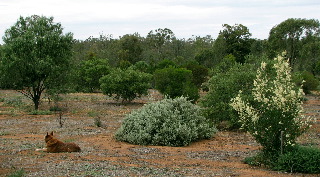
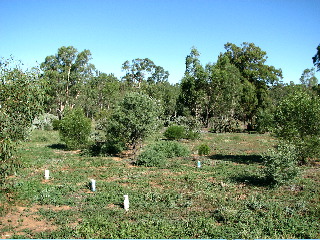

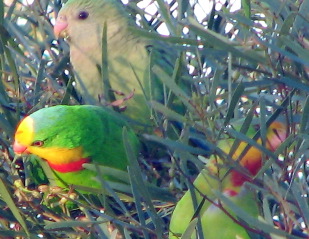
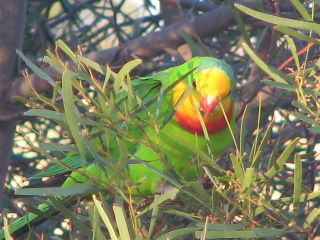
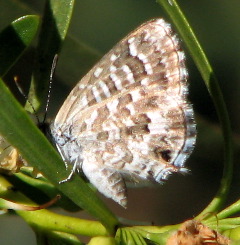
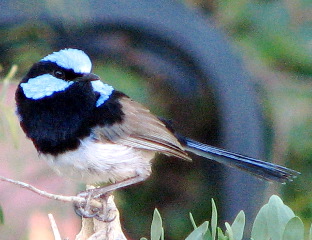
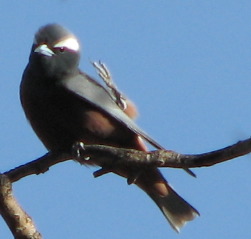
This page depicting 'Philip's' revegetation plots in the Deniliquin district is, like the plots, a work in progress . |
The customers of Australian Ornithological Services support work on these projects |
|
| Philip grows many thousands of plants for these revegetation plots; however, none would make it into the ground without the care of Steve Seymour who nurtures them while Philip is away on tour. We are eternally grateful to Steve. | ||
Gulpa Island site commenced 1995
|
||
 |
 |
|
| Gulpa Island revegatation plot November 2007 | unidentified insect on Myoporum platycarpum | |
 |
 |
 |
| superb parrots in Acacia hakeoides 11 November 2008 | ||
 |
 |
 |
| saltbush blue | superb fairywren | white-browed woodswallow |
Gulpa revegetation site (1995)
|
| plant species planted 1995 to 2008 Gulpa Island plot | |
| white cyress pine | Callitris columellaris |
| silky-heads | Cymbopogom obtectus |
| kangaroo grass | Themeda australis |
| bulloak | Casuarina luehmanni |
| needlewood | Hakia leucoptera |
| hooked needlewood | Hakia tephrosperma |
| leafless cherry | Exocarpus aphyllus |
| slender-leaf mistletoe | Amyema linophyllum spp. orientale |
| fleshy-leaf mistletoe | Amyema miraculosum spp. booramii |
| wire-leaf mistletoe | Amyema preissii |
| grey mistletoe | Amyema quandang var. quandang |
| harlequin mistletoe | Lysiana exocarpus spp. exocarpus |
| quandong | Santalum acuminatum |
| sandalwood | Santalum lanceolatum |
| old man saltbush |
Atriplex nummularia |
| bladder saltbush ** | Atriplex vesicaria |
| mallee goosefoot | Chenopodium anidiophyllum |
| ruby saltbush | Enchylaena tomentose |
| yanga bush | Maireana brevifolia |
| satiny bluebush | Maireana georgei |
| eastern cottonbush | Maireana microphylla |
| climbing saltbush | Rhagodia nutans |
| mealy saltbush | Rhagodia parabolica |
| thorny saltbush | Rhagodia spinescens |
| round-leaf pigface | Disphyma clavellatum |
| small-leaf clematis | Clematis microphylla |
| native blackthorn | Bursaria spinosa |
| weeping pittosporum | Pittosporum phylliraeoides |
| grey wattle | Acacia brachybotrya |
| western black wattle | Acacia hakeoides |
| hickory wattle | Acacia implexa |
| yarran | Acacia melvillei |
| sandhill wattle | Acacia ligulata |
| hybrid wattle (?) | Acacia loderi x melvillei |
| mallee wattle | Acacia montana |
| miljee | Acacia oswaldii |
| boree | Acacia pendula |
| golden wattle | Acacia pycnantha |
| needle wattle | Acacia rigens |
| cooba | Acacia salicinia |
| golden wattle | Acacia pycnantha |
| prickly wattle | Acacia victoriae |
| spring-pod cassia | Cassia circinnata |
| desert cassia | Cassia eremophila var. coriacea |
| punty bush | Cassia eremophila var. eremophila |
| punty bush | Cassia eremophila var zygophylla |
| punty bush | Cassia eremophila var platypoda |
| narrow-leafed hopbush | Dodonaea attenuata |
| wedge-leafed hopbush | Dodonaea cuneata |
| rosewood * | Helerodendrum oleifolium |
| shrubby rice-flower | Pimelia microcephala |
| moonah | Melaleuca lanceolata |
| prickly bottlebush | Callistemon brachyandrus |
| yellow gum | Eucalyptus leucoxylon var. rosea |
| yellow box | Eucalyptus melliodora |
| grey box | Eucalyptus microcarpa |
| native jasmine | Jasminum lineare |
| emubush | Eremophila longifolia |
| spotted fuchsia | Eremophila maculata |
| turkeybush | Myoporum deserti |
| western boobialla | Myoporum montanum |
| sugarwood | Myoporum platycarpum |
| showy daisy-bush | Olearia pimeleoides |
| Chinese-shrub | Cassinia arcuata |
Wanganella sandhill
|
| The Wanganella sandhill site plantings 2001 to 2008 | |
| white cyress pine | Callitris columellaris note: now gracilis |
| bulloak | Casuarina luehmanni |
| needlewood | Hakea leucoptera |
| hooked needlewood | Hakea tephrosperma |
| quandong | Santalum acuminatum |
| sandalwood | Santalum lanceolatum |
| old man saltbush |
Atriplex nummularia |
| ruby saltbush | Enchylaena tomentose |
| thorny saltbush | Rhagodia spinescens |
| climbing saltbush | Rhagodia nutans |
| small-leaf clematis | Clematis microphylla |
| native blackthorn | Bursaria spinosa |
| weeping pittosporum | Pittosporum phylliraeoides |
| grey wattle | Acacia brachybotrya |
| sandhill wattle | Acacia ligulata |
| miljee | Acacia oswaldii |
| boree | Acacia pendula |
| needle wattle | Acacia rigens |
| cooba (native willow) | Acacia salicinia |
| prickly wattle | Acacia victoriae |
| punty bush | Cassia eremophila var. eremophila |
| punty bush | Cassia eremophila var zygophylla |
| punty bush | Cassia eremophila var platypoda |
| wilga* | Geijera parviflora |
| narrow-leafed hopbush | Dodonaea attenuata |
| shrubby rice-flower | Pimelia microcephala |
| common fringe-myrtle | Calytrix tetragona |
| moonah | Melaleuca lanceolata |
| prickly bottlebush | Callistemon brachyandrus |
| native jasmine | Jasminum lineare |
| emubush | Eremophila longifolia |
| turkeybush | Myoporum deserti |
| western boobialla | Myoporum montanum |
| sugarwood | Myoporum platycarpum |
| showy daisy-bush | Olearia pimeleoides |
| seeding attempts at the Wanganella site 2001 to 2008 | |
| silky-heads ** | Cymbopogom obtectus |
| small Flinders grass ** | Iseilema membranaceum |
| kangaroo grass ** | Themeda australis |
| grey wattle *** | Acacia brachybotrya |
| western black wattle *** | Acacia hakeoides |
| miljee *** | Acacia oswaldii |
| punty bush several varieties *** | Cassia spp |
| eremophila several varieties *** | Eremophila spp. |
| cooba *** | Acacia salicinia |
| narrow-leafed hopbush *** | Dodonaea attenuata |
| old man saltbush ** |
Atriplex nummularia |
| bladder saltbush ** | Atriplex vesicaria |
| * no success as yet ** spread by hand *** direct seeded |
|
| Monimail revegetation site commenced 2002 |
 |
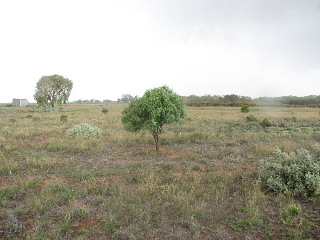 |
| Atriplex nummularia (old man saltbush) | Eremophila longifolia, Acacia pendula in background |
 |
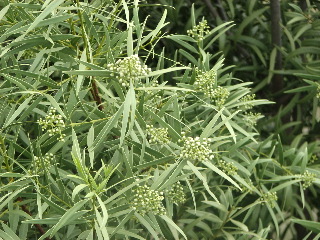 |
| Santalum acuminatum (quandong) | Santalum acuminatum flowering |
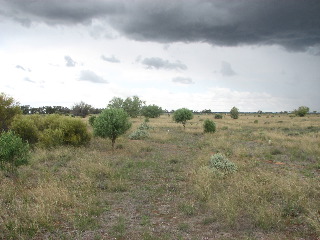 |
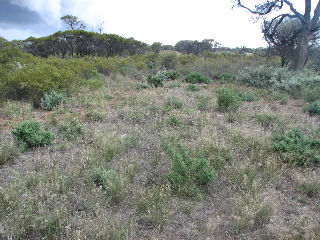 |
| Eremophila longifolia with an original clump of Hakea tephrosperma on left-hand side | Maireana species with another original clump of Hakea tephrosperma in the background |
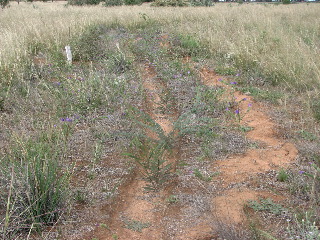 |
|
| direct seeding line of Acacias |
Monimail revegetation site (2002)
|
| MonimaipMonimail plantings 2002 to 2008ies planted 2002 to 2008 | |
| Common names | Latin names |
| white cyress pine | Callitris columellaris |
| bulloak | Casuarina luehmanni |
| needlewood | Hakea leucoptera |
| leafless cherry | Exocarpus aphyllus |
| quandong | Santalum acuminatum |
| old man saltbush |
Atriplex nummularia |
| bitter saltbush | Atriplex stipitata |
| bladder saltbush | Atriplex vesicaria |
| ruby saltbush | Enchylaena tomentose |
| yanga bush | Maireana brevifolia |
| satiny bluebush | Maireana georgei |
| Maireana turbinata | |
| black bluebush | Maireana pyramidata |
| climbing saltbush | Rhagodia nutans |
| round-leaf pigface | Disphyma clavellatum |
| small-leaf clematis | Clematis microphylla |
| native blackthorn | Bursaria spinosa |
| weeping pittosporum | Pittosporum phylliraeoides |
| grey wattle | Acacia brachybotrya |
| western black wattle | Acacia hakeoides |
| yarran | Acacia melvillei |
| sandhill wattle | Acacia ligulata |
| nelia (1) | Acacia loderi |
| hybrid wattle (?) | Acacia loderi x melvillei |
| miljee | Acacia oswaldii |
| boree | Acacia pendula |
| cooba | Acacia salicinia |
| prickly wattle | Acacia victoriae |
| spring-pod cassia | Cassia circinnata |
| desert cassia | Cassia eremophila var. coriacea |
| punty bush | Cassia eremophila var. eremophila |
| punty bush | Cassia eremophila var zygophylla |
| punty bush | Cassia eremophila var platypoda |
| woody cassia | Cassia phyllodinea |
| desert broombush | Templetonia egena |
| wilga | Geijera parviflora |
| narrow-leafed hopbush | Dodonaea attenuata |
| rosewood | Helerodendrum oleifolium |
| shrubby rice-flower | Pimelia microcephala |
| moonah | Melaleuca lanceolata |
| prickly bottlebush | Callistemon brachyandrus |
| quorn mallee | Eucalyptus porosa |
| native jasmine | Jasminum lineare |
| emubush | Eremophila longifolia |
| spotted fuchsia | Eremophila maculata |
| turkeybush | Myoporum deserti |
| western boobialla | Myoporum montanum |
| sugarwood | Myoporum platycarpum |
| showy daisy-bush | Olearia pimeleoides |
| sespeseeding attempts at the Monimail site 2002 to 2008 | |
| small Flinders grass | Iseilema membranaceum |
| kangaroo grass | Themeda australis |
| silky-heads | Cymbopogom obtectus |
| old man saltbush | Atriplex nummularia |
| bladder saltbush | Atriplex vesicaria |
| grey wattle | Acacia brachybotrya |
| western black wattle | Acacia hakeoides |
|
|
| Plant nursery | ||
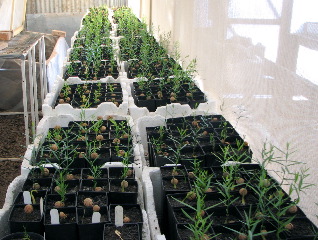 |
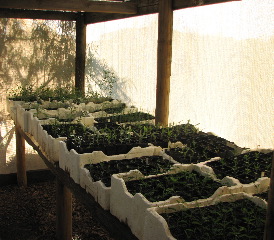 |
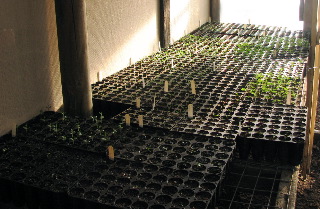 |
| Santalum acuminatum (quandong) seedlings | Banksia marginata, native jasmine, cypress pine, Eremophila longifolia among others | mostly Acacia spp. |
| Union Plain |
| Front plot | |
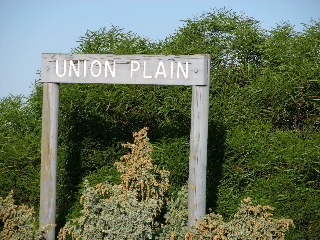 |
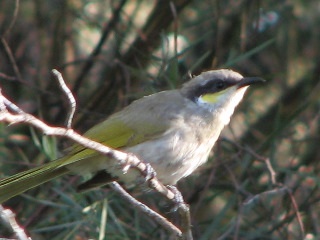 |
| singing honeyeater | |
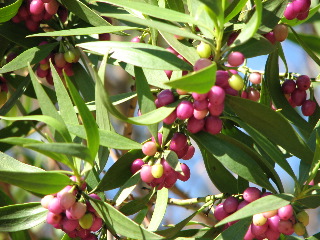 |
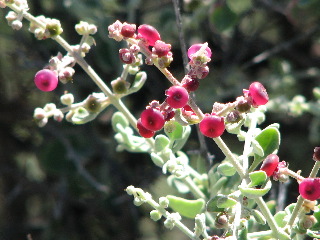 |
| Myoporum montanum | Rhagodia spinescens (thorny saltbush) |
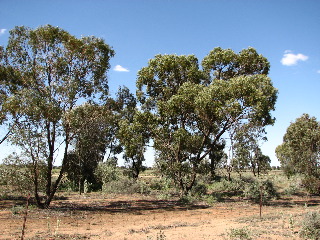 |
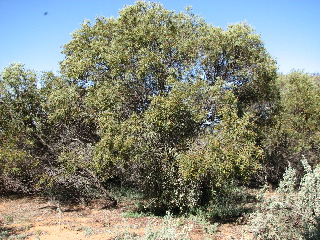 |
| Eucalyptus largiflorens (black box) and Atriplex nummularia (old man saltbush) | Acacia melvillei |
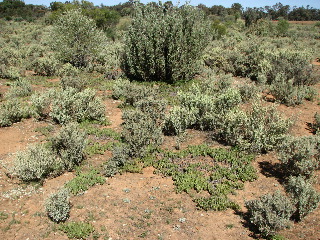 |
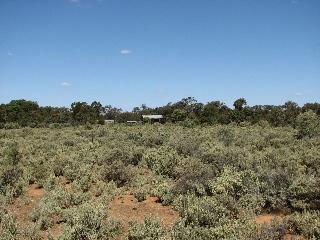 |
| Disphyma clavellatum (round-leaf pigface), Atriplex vesicaria (bladder saltbush), Atriplex nummularia (old man saltbush) | Atriplex vesicaria (bladder saltbush) |
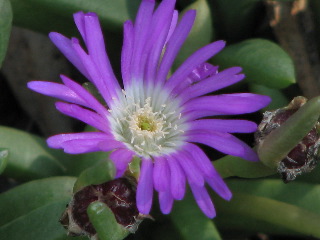 |
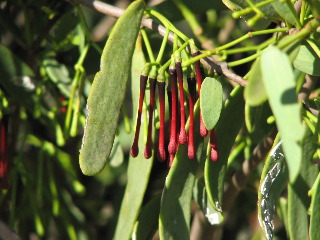 |
| Disphyma clavellatum (round-leaf pigface) | Amyema miraculosum spp. booramii (fleshy mistletoe) |
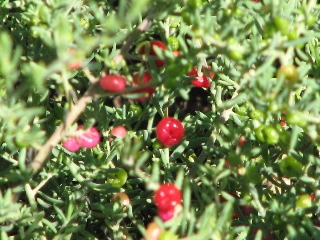 |
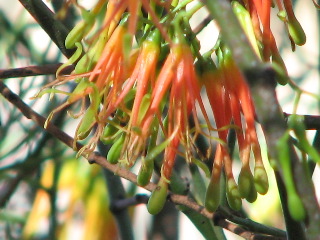 |
| Enchylaena tomentose (ruby saltbush) | Amyema preissii (wire-leaf mistletoe) |
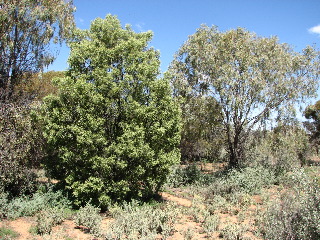 |
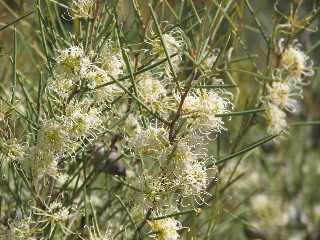 |
| flowering Santalum acuminatum (quandong) | Flowering Hakea leucoptera (needlewood) |
| Union Plain garden and other revegetation areas | |
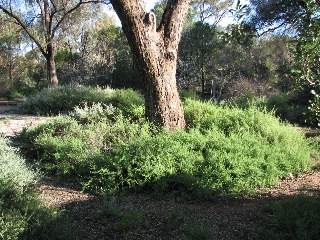 |
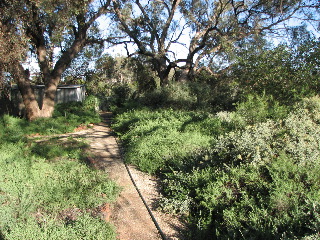 |
| Enchylaena tomentose (ruby saltbush) | Enchylaena tomentose (ruby saltbush) |
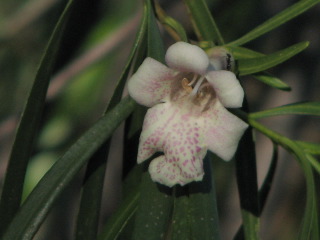 |
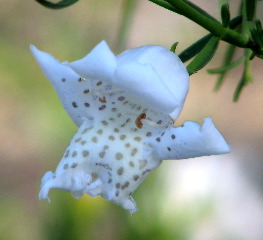 |
| Eremophila bignoniiflora | Eremophila polyclada (flowering lignum) |
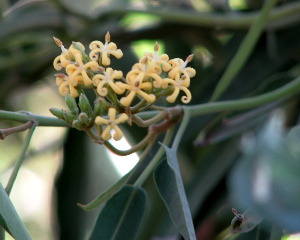 |
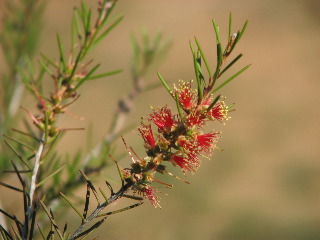 |
| Parsonsia eucalyptophylla (gargaloo) | Callistemon brachyandrus |
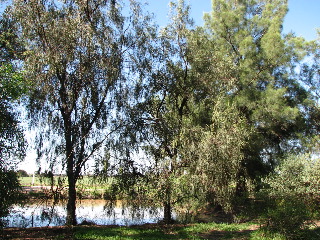 |
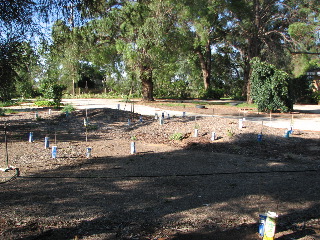 |
| Aacia dealbata by the dam | new sandhill area |
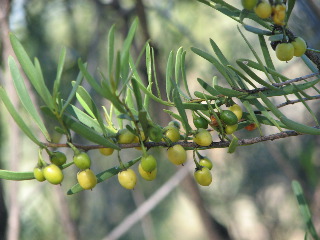 |
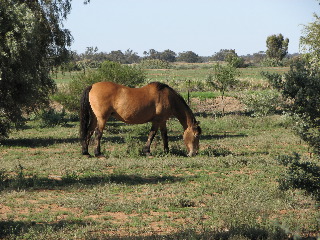 |
| Eremophila desertii | Tuppence |
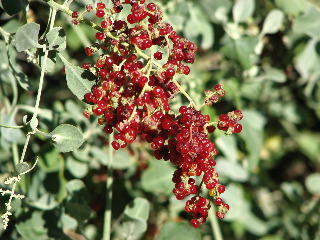 |
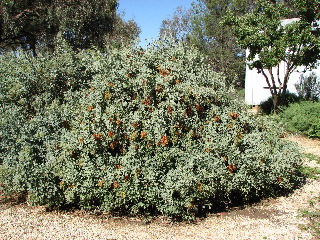 |
| Rhagodia parabolica (mealy saltbush) | Rhagodia parabolica (mealy saltbush) |
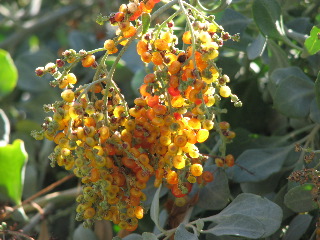 |
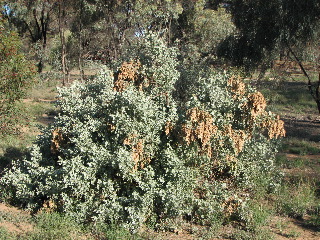 |
| Rhagodia parabolica (mealy saltbush) | Atriplex nummularia (old man saltbush) |
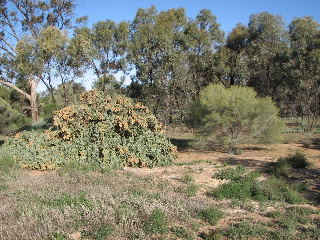 |
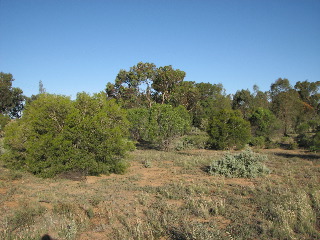 |
| back plot with Atriplex nummularia (old man saltbush) | back plot |
| A tawny frogmouth with two babies (19 December 2008) in an Acacia salicina beside the dam; parent on eggs first sighted 26 November. | |
 |
|
| Union Plain write up | |
| update: 2 December 2009 | |